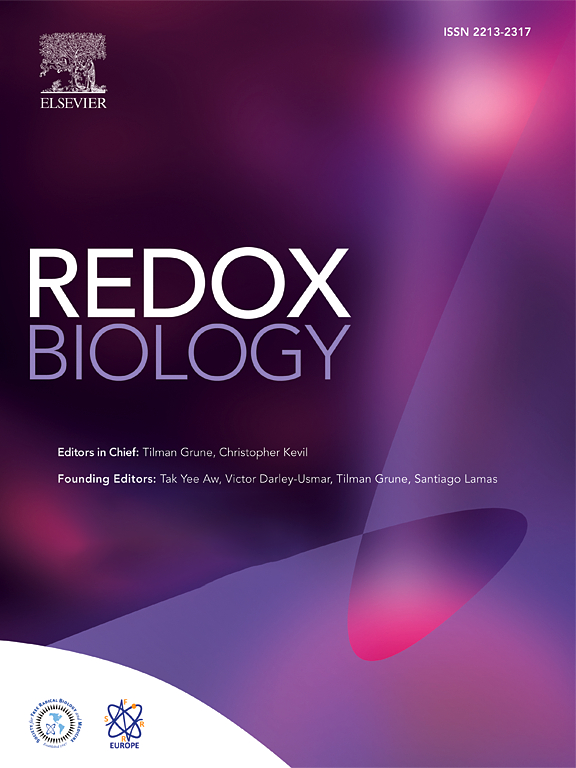Knockout of the sulfide: quinone oxidoreductase SQR reduces growth of HCT116 tumor xenograft
IF 10.7
1区 生物学
Q1 BIOCHEMISTRY & MOLECULAR BIOLOGY
引用次数: 0
Abstract
Colorectal cancer (CRC) exhibits significant diversity and heterogeneity, posing a requirement for novel therapeutic targets. Polysulfides are associated with CRC progression and immune evasion, but the underlying mechanisms are not fully understood. Sulfide: quinone oxidoreductase (SQR), a mitochondrial flavoprotein, catalyzes hydrogen sulfide (H2S) oxidation and polysulfides production. Herein, we explored its role in CRC pathogenesis and its potential as a therapeutic target. Our findings revealed that SQR knockout disrupted polysulfides homeostasis, diminished mitochondrial function, impaired cell proliferation, and triggered early apoptosis in HCT116 CRC cells. Moreover, the SQR knockout led to markedly reduced tumor sizes in mice models of colon xenografts. Although the transcription of glycolytic genes remained largely unchanged, metabolomic analysis demonstrated a reprogramming of glycolysis at the fructose-1,6-bisphosphate degradation step, catalyzed by aldolase A (ALDOA). Both Western blot analysis and enzymatic assays confirmed the decrease in ALDOA levels and activity. In conclusion, the study establishes the critical role of SQR in mitochondrial function and metabolic regulation in CRC, with its knockout leading to metabolic reprogramming and diminished tumor growth in HCT116 tumor xenografts. These insights lay a foundation for the development of SQR-targeted therapies for CRC.

敲除硫化物:醌氧化还原酶SQR可减少HCT116肿瘤异种移植物的生长
结直肠癌(CRC)表现出显著的多样性和异质性,需要新的治疗靶点。多硫化物与结直肠癌进展和免疫逃避有关,但其潜在机制尚不完全清楚。硫化物:醌氧化还原酶(SQR),一种线粒体黄素蛋白,催化硫化氢(H2S)氧化和多硫化物的产生。在此,我们探讨了其在结直肠癌发病机制中的作用及其作为治疗靶点的潜力。我们的研究结果表明,在HCT116 CRC细胞中,SQR敲除破坏了多硫化物稳态,降低了线粒体功能,损害了细胞增殖,并引发了早期凋亡。此外,敲除SQR导致结肠异种移植小鼠模型中肿瘤大小明显减小。虽然糖酵解基因的转录基本保持不变,但代谢组学分析表明,糖酵解在醛缩酶a (ALDOA)催化的果糖-1,6-二磷酸降解步骤中发生了重编程。Western blot分析和酶促试验均证实ALDOA水平和活性下降。综上所述,本研究确立了SQR在CRC线粒体功能和代谢调节中的关键作用,敲除SQR可导致HCT116肿瘤异种移植物的代谢重编程和肿瘤生长减弱。这些见解为开发针对结直肠癌的sqr靶向治疗奠定了基础。
本文章由计算机程序翻译,如有差异,请以英文原文为准。
求助全文
约1分钟内获得全文
求助全文
来源期刊

Redox Biology
BIOCHEMISTRY & MOLECULAR BIOLOGY-
CiteScore
19.90
自引率
3.50%
发文量
318
审稿时长
25 days
期刊介绍:
Redox Biology is the official journal of the Society for Redox Biology and Medicine and the Society for Free Radical Research-Europe. It is also affiliated with the International Society for Free Radical Research (SFRRI). This journal serves as a platform for publishing pioneering research, innovative methods, and comprehensive review articles in the field of redox biology, encompassing both health and disease.
Redox Biology welcomes various forms of contributions, including research articles (short or full communications), methods, mini-reviews, and commentaries. Through its diverse range of published content, Redox Biology aims to foster advancements and insights in the understanding of redox biology and its implications.
 求助内容:
求助内容: 应助结果提醒方式:
应助结果提醒方式:


